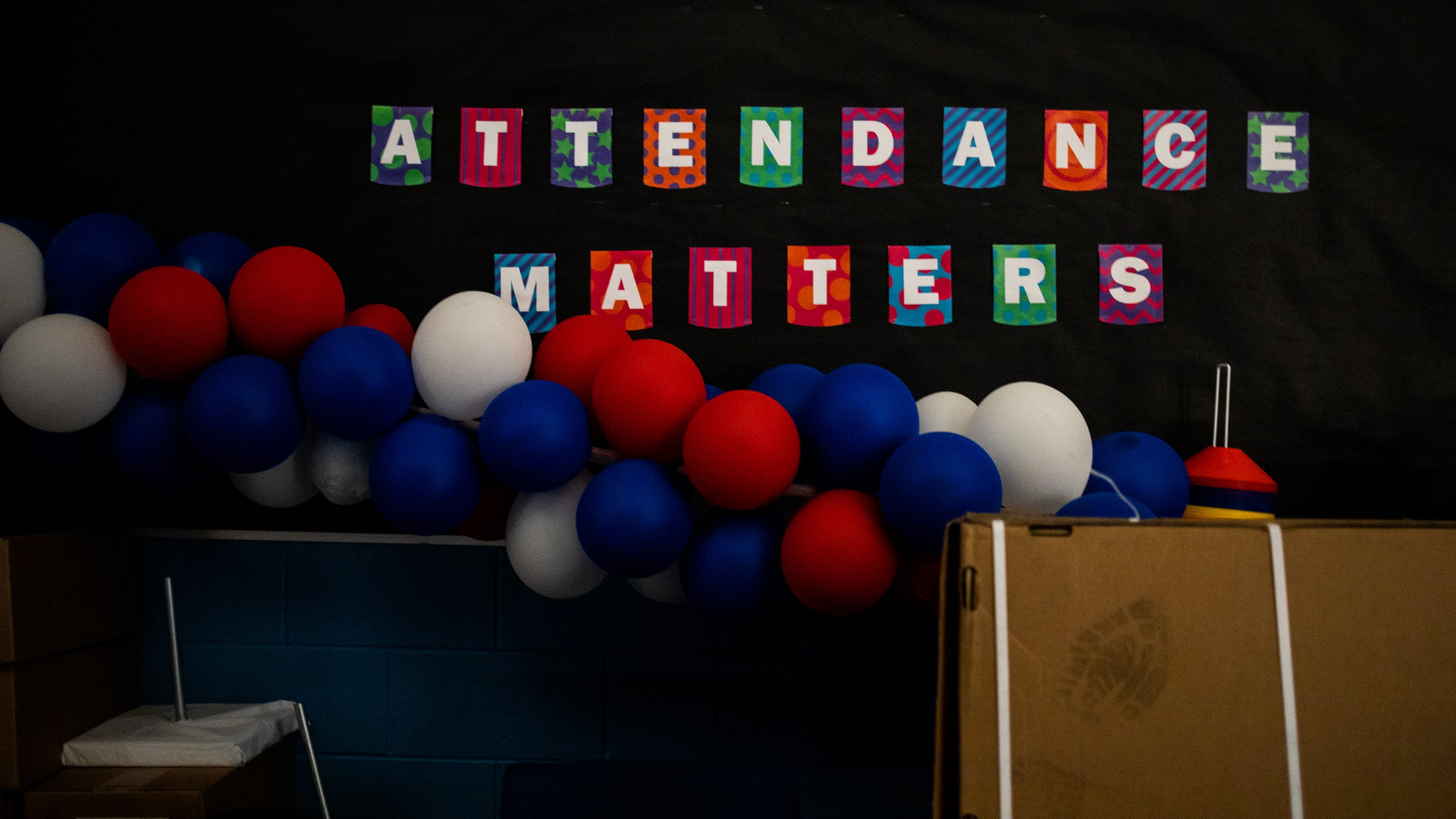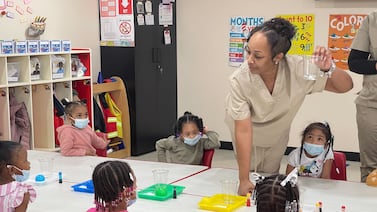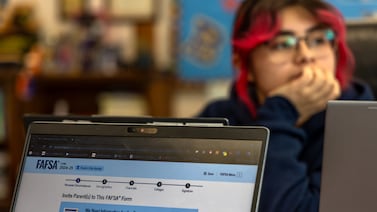Sign up for Chalkbeat’s free weekly newsletter to get essential education news delivered to your inbox.
Last year, Santa Fe schools put in a lot of work to try to get students to show up to school consistently. It was a priority after chronic absenteeism doubled during the 2021-22 school year, compared to before the pandemic.
The New Mexico district hired two additional attendance coaches, for a total of five, to help every school form a team focused on boosting attendance. Those staffers got extra pay and training. And schools used COVID relief funds to reward students who improved their attendance with incentives like a pop-up science exhibit hosted by a local children’s museum.
But despite those efforts, the share of students who missed 10% or more of their school year, the threshold New Mexico and most other states use to define chronic absenteeism, didn’t budge. Just over half were chronically absent — the same as the prior year.
“We know we still have work to do,” said Crystal Ybarra, the district’s chief equity, diversity, and engagement officer, who is overseeing the attendance initiative. “We’re still trying to figure out the steps post-pandemic. Everybody wants to see a quick fix, and that’s just not how initiatives work.”
What happened in Santa Fe highlights multiple challenges schools nationwide are encountering as they try to drive down stubbornly high absence rates. Students’ mindsets about attending school in person every day have shifted, staff say. Families are more likely to keep sick kids home. In some places, more families are experiencing economic hardships and housing instability.
Emerging state data, compiled by Chalkbeat, suggests that the stunning rise in students missing school did not come close to returning to pre-pandemic levels last school year.
Chronic absenteeism worsened in at least 40 states during the 2021-22 school year, according to data compiled by Thomas Dee, a Stanford University education professor, in partnership with the Associated Press. The needle hasn’t moved much in the handful of states that have released data for last school year so far.
In New Mexico, for example, chronic absenteeism shot up to 40% two school years ago and remained at 39% last year, compared to 18% the year before the pandemic. Similar trends have emerged in Connecticut, Massachusetts, Ohio, and Virginia.
“The consequences of kids being sporadically in school and not fully engaging take a while to really shift,” said Hedy Chang, the executive director of Attendance Works, a nonprofit that focuses on raising school attendance. “It’s definitely not something that happens overnight, and may take longer than we would like.”
Become a Chalkbeat sponsor
Illnesses other than COVID, such as RSV, as well as confusion over when to send sick children to school, likely played a role, school staff and attendance experts said. Many families got in the habit of keeping kids home if they had any symptom of illness. When Los Angeles Unified school officials talked with 9,000 families last year as part of an effort to reduce chronic absenteeism, non-COVID illness was one of the three major themes that came up.
“We went from this place of requiring students to be out for certain symptoms that they might have in the 2021-22 school year,” Ybarra said, “to trying to navigate what was appropriate and what wasn’t this past school year.”
Elevated mental health struggles also likely contributed. Some students feel a lingering disconnect from their school and peers. School refusal seems to have intensified following the pandemic, some parents and educators say. In Santa Fe, many students who missed class or asked to transfer to the GED program last year reported feeling anxious about coming to school, Ybarra said.
Now that more schools provide devices to every student and post assignments online, some students have also come to believe that they can take a few days off and still stay on top of their work.
Greg Moody, a school official in Florida’s Orange County district who oversees attendance, said the ability to do assignments remotely had contributed to a “shift in mindset” about the importance of showing up to class every day. In his district, chronic absenteeism nearly doubled from 21% the year before the pandemic to 40% in the 2021-22 school year.
Amana Levi, who helps Orange County schools address truancy issues, said parents report a variety of reasons their kids stay home. But last year she frequently heard: “Well, my child needed a day off.” Sometimes that stemmed from a mental health issue, she said, and sometimes it didn’t.
In response, Levi is hosting an online training for parents that will talk about why attendance matters — for academic and other reasons — and what parents can do if they get a letter saying their child has missed a lot of school.
“It’s important that we impress upon parents: We get it, we’re all here, we’re all experiencing similar types of things,” Levi said. But her message is: “You’ve got to come to school. We are here to help as much as we can.”
Schools seek more input on attendance struggles
Schools that started attendance initiatives last year that haven’t gotten the results they wanted should try to figure out why that may be, Chang of Attendance Works said. Staff can look at how many students were directly affected by such efforts, and talk with students and families about what worked and what didn’t.
In Santa Fe, Ybarra is hoping to build on some of the positive changes in school culture that she observed last year, while making adjustments to the district’s overall strategy.
Become a Chalkbeat sponsor
Attendance coaches realized that they previously hadn’t taught many staff members to reach out to students about attendance. So this year, they trained entire schools to do it.
With the help of a $500,000 state grant, Santa Fe is sending home letters to recognize students for good attendance and remind families to return after longer school breaks. The district also hired an organization to train high school teams to watch ninth grade attendance — a challenging transition year for many teens — and will pay staff extra to make home visits to freshmen.
School staff are prioritizing chronically absent kids for evaluations to see if they need extra academic help, or support for a disability. The goal is to “try to make them more successful so they feel like they can return,” Ybarra said. In the past, those students were often overlooked.
And last month, school officials met with students from two schools struggling with attendance to listen to some of the barriers that keep them from going to school regularly and what has been helpful to get them back on track.
Students reported getting sick, lacking transportation to school, having family problems, facing mental health issues, and caring for siblings. One middle schooler pointed to the benefits of having a day to do catch-up work when they returned from a long period of absence.
“I didn’t feel so behind when I went back into the classroom,” the student told school staff.
Orange County schools tried something similar this summer by paying a dozen social workers to call the families of students who missed 20 or more days of school last year.
The goal was to figure out what had kept students from attending and offer support “so we could start with a fresh slate,” said Juliane Cross, a senior administrator in the district’s social services department.
Social workers heard many of those families were moving around a lot, struggling to afford stable housing — a common issue in the Orlando area that has intensified in recent years. Other parents worked nights and couldn’t wake their kids up in time for class.
Social workers connected families to housing resources and made sure they knew about the federal program that offers help to students experiencing homelessness. It’s an initiative Cross hopes to repeat.
Become a Chalkbeat sponsor
“Several of the parents were just like ‘Wow, thank you for calling,’ as if they were really surprised that this effort was made to just check on them and try to address that attendance situation,” she said. “They appreciated having that interaction.”
Kalyn Belsha is a senior national education reporter based in Chicago. Contact her at kbelsha@chalkbeat.org.







